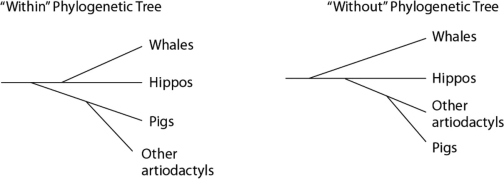Multiple Choice
Please use the following information to answer the question(s) below.
Traditionally, whales and hippopotamuses have been classified in different orders, the Cetacea and the Artiodactyla, respectively. Recent molecular evidence, however, indicates that the whales' closest living relatives are the hippos. This has caused some zoologists to lump the two orders together into a single clade, the Cetartiodactyla. There is no consensus on whether the Cetartiodactyla should be accorded order status or superorder status. This is because it remains unclear whether the whale lineage diverged from the lineage leading to the hippos before or after the other members of the order Artiodactyla (pigs, camels, etc.) diverged (see Figure 20.5) .  Figure 20.5
Figure 20.5
-Placing whales and hippos in the same clade means that
A) these organisms are phenotypically more similar to each other than to any others shown on the trees in Figure 20.5.
B) their morphological similarities are probably homoplasies.
C) they had a common ancestor.
D) all three of the responses are correct.
Correct Answer:

Verified
Correct Answer:
Verified
Q5: <img src="https://d2lvgg3v3hfg70.cloudfront.net/TB6148/.jpg" alt=" Figure 20.2 -From
Q8: <img src="https://d2lvgg3v3hfg70.cloudfront.net/TB6148/.jpg" alt=" Figure 20.1 -Which
Q11: In figure shown below, which similarly inclusive
Q12: Which kingdom has been replaced with two
Q24: Three living species X,Y,and Z share a
Q29: If it turns out that the whale
Q35: Linnaeus was a "fixist" who believed that
Q42: In a comparison of birds and mammals,
Q59: Please use the following information to answer
Q60: Scientists discovered a fossil in China that